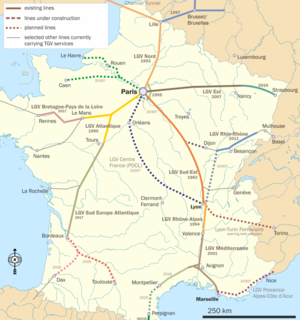
Back TGV Afrikaans قطارات فائقة السرعة (الشركة الوطنية للسكك الحديدية) Arabic TGV Byelorussian TGV BE-X-OLD TGV Bulgarian Tren Tizh-ha-Tizh Breton TGV BS TGV Catalan TGV Czech TGV Welsh
 TGV 2N2 at Gare de l'Est in Paris, 2013 | |
| Overview | |
|---|---|
| Locale |
|
| Dates of operation | 1981–present |
| Technical | |
| Track gauge | 1,435 mm (4 ft 8+1⁄2 in) (standard gauge) |
| Other | |
| Website | www |
 High-speed lines in France |
The TGV (French: [teʒeve]; Train à Grande Vitesse, [tʁɛ̃ a ɡʁɑ̃d vitɛs] , "high-speed train"; formerly TurboTrain à Grande Vitesse) is France's intercity high-speed rail service. With commercial operating speeds of up to 320 km/h (200 mph) on the newer lines,[1] the TGV was conceived at the same period as other technological projects such as the Ariane 1 rocket and Concorde supersonic airliner; sponsored by the Government of France, those funding programmes were known as champion national ("national champion") policies. In 2023 the TGV network in France carried 122 million passengers.[2]
The state-owned SNCF started working on a high-speed rail network in 1966. It presented the project to President Georges Pompidou in 1974 who approved it. Originally designed as turbotrains to be powered by gas turbines, TGV prototypes evolved into electric trains with the 1973 oil crisis. In 1976 the SNCF ordered 87 high-speed trains from Alstom. Following the inaugural service between Paris and Lyon in 1981 on the LGV Sud-Est, the network, centred on Paris, has expanded to connect major cities across France, including Marseille, Lille, Bordeaux, Strasbourg, Rennes and Montpellier, as well as in neighbouring countries on a combination of high-speed and conventional lines. The success of the first high-speed service led to a rapid development of Lignes à Grande Vitesse (LGVs, "high-speed lines") to the south (Rhône-Alpes, Méditerranée, Nîmes–Montpellier), west (Atlantique, Bretagne-Pays de la Loire, Sud Europe Atlantique), north (Nord, Interconnexion Est) and east (Rhin-Rhône, Est). Since it was launched, the TGV has not recorded a single passenger fatality in an accident on normal, high-speed service.
A specially modified TGV high-speed train known as Project V150, weighing only 265 tonnes, set the world record for the fastest wheeled train, reaching 574.8 km/h (357.2 mph) during a test run on 3 April 2007.[3] In 2007, the world's fastest scheduled rail journey was a start-to-stop average speed of 279.4 km/h (173.6 mph) between the Gare de Champagne-Ardenne and Gare de Lorraine on the LGV Est,[4][5] not surpassed until the 2013 reported average of 283.7 km/h (176.3 mph) express service on the Shijiazhuang to Zhengzhou segment of China's Shijiazhuang–Wuhan high-speed railway.[6] During the engineering phase, the Transmission Voie-Machine (TVM) cab-signalling technology was developed, as drivers would not be able to see signals along the track-side when trains reach full speed. It allows for a train engaging in an emergency braking to request within seconds all following trains to reduce their speed; if a driver does not react within 1.5 km (0.93 mi), the system overrides the controls and reduces the train's speed automatically. The TVM safety mechanism enables TGVs using the same line to depart every three minutes.[7][8]
The TGV system itself extends to neighbouring countries, either directly (Italy, Spain, Belgium, Luxembourg and Germany) or through TGV-derivative networks linking France to Switzerland (Lyria), to Belgium, Germany and the Netherlands (former Thalys), as well as to the United Kingdom (Eurostar). Several future lines are under construction or planned, including extensions within France and to surrounding countries. The Mont d'Ambin Base Tunnel, part of the LGV Lyon–Turin that is currently under construction, is set to become the longest rail tunnel in the world. Cities such as Tours and Le Mans have become part of a "TGV commuter belt" around Paris; the TGV also serves Charles de Gaulle Airport and Lyon–Saint-Exupéry Airport. A visitor attraction in itself, it stops at Disneyland Paris and in southern tourist cities such as Avignon and Aix-en-Provence as well. Brest, Chambéry, Nice, Toulouse and Biarritz are reachable by TGVs running on a mix of LGVs and modernised lines. In 2007, the SNCF generated profits of €1.1 billion (approximately US$1.75 billion, £875 million) driven largely by higher margins on the TGV network.[9][10]
- ^ Amedeo, Fabrice (17 December 2007). "Le TGV roulera bientôt à 360 km/h". Le Figaro (in French). Retrieved 6 July 2023.
- ^ "SNCF : TGV, TER… les chiffres d'une année 2023 record" (in French). Europe 1. 19 January 2024.
- ^ "French Train Hits 357 mph Breaking World Speed Record". Fox News. 4 April 2007. Archived from the original on 4 May 2011. Retrieved 11 February 2010.
- ^ Taylor, Dr Colin (4 September 2007). "World Speed Survey 2007: New lines boost rail's high speed performance". Railway Gazette International. Archived from the original on 9 August 2011. Retrieved 6 July 2023.
- ^ Cite error: The named reference
worldspeedsurvey2007pdfwas invoked but never defined (see the help page). - ^ "World Speed Survey 2013: China sprints out in front". Railway Gazette International. Archived from the original on 26 June 2018. Retrieved 2 July 2013.
- ^ "Sympozjum CS Transport w CNTK" (in Polish). Archived from the original on 26 June 2018. Retrieved 18 May 2009.
- ^ Gruere, Y (1989). "TVM 400-a modular and flexible ATC system".
- ^ Gow, David (9 July 2008). "Europe's rail renaissance on track". guardian.co.uk. London. Retrieved 9 February 2010.
- ^ Fried, Ben (15 July 2008). "French Trains Turn $1.75B Profit, Leave American Rail in the Dust". Streetsblog New York City. streetsblog.org. Archived from the original on 22 March 2010. Retrieved 9 February 2010.